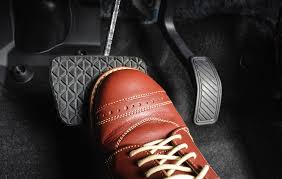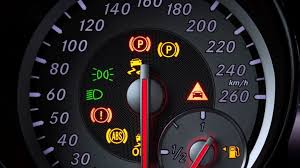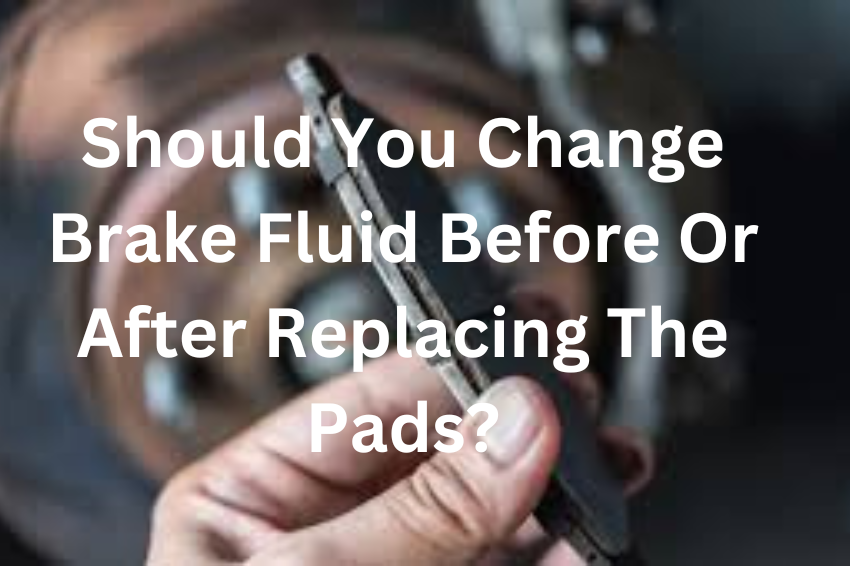Changing brake pads typically don’t require a full brake fluid flush, but bleeding is recommended. Flushing becomes necessary if the fluid is old ( over 3 years) or contaminated.
4 Common Signs You Need A Brake Fluid Flush Along With New Pads
Here are some key signs that a brake fluid flush is recommended alongside installing new pads:
Spongy Brake Pedal:

A brake pedal that feels soft and mushy when pressed is a classic sign of air in the brake lines.
While worn pads can contribute to this feeling, it also suggests the fluid might be old or contaminated, trapping air pockets that reduce braking effectiveness.
If you experience a spongy pedal after replacing the pads, it’s best to have a qualified mechanic check the brake system for leaks and recommend if a flush is necessary.
Decreased Braking Performance:
You should feel a confident response from your brakes when you apply pressure to the pedal.
If your car seems to take longer to slow down than usual, even after replacing the pads, it could be due to degraded brake fluid.
Over time, brake fluid absorbs moisture from the air, which lowers its boiling point.
This can lead to the fluid boiling under hard braking conditions, creating vapor bubbles that compromise the system’s ability to transmit pressure.
If you suspect degraded fluid, consult a mechanic about a flush to restore optimal braking performance.
A Department of Transportation (DOT) specification code is printed on your brake fluid reservoir.
This code indicates the fluid’s boiling point.
Generally, a higher DOT code signifies a higher boiling point.
Dark Or Dirty Brake Fluid:

Fresh brake fluid is typically light brown or amber.
Suppose you check your brake fluid reservoir (usually located under the hood with a translucent plastic container) and the fluid appears dark, cloudy, or greenish.
In that case, it’s a strong indication of contamination or age.
Contamination can occur from internal leaks or moisture ingress, while age simply means the fluid has absorbed too much moisture and needs replacement.
In either case, a flush is necessary to ensure clean, effective fluid circulates through your braking system.
Warning Light:

Some vehicles have a brake system warning light on the dashboard that can illuminate for various reasons.
While a low fluid level might trigger the light (indicating a potential leak that necessitates a flush after repair), other issues like faulty ABS (Anti-lock Braking System) components can also cause it to come on.
If your warning light turns on after replacing the pads, it’s crucial to have a mechanic diagnose the problem.
Depending on the cause, a brake flush might be part of the solution.
Best Order To Change Brake Fluid And Pads: Flush Vs Replace?
Replacing brake pads is an essential maintenance task, but a full brake fluid flush isn’t mandatory in most situations.
However, a process called bleeding is highly recommended to remove any air bubbles that might enter the system during the pad change.
Bleeding involves carefully opening a valve (called a bleeder screw) on each brake caliper to allow trapped air to escape, ensuring proper fluid circulation and optimal braking performance.
Think of bleeding like topping off your engine oil, it removes impurities but doesn’t replace the entire volume.
This is where brake fluid age and condition come into play.
If your brake fluid is older than 3 years or appears contaminated (dark, dirty, or greenish), a full flush becomes more important.
Flushing replaces all the old fluid with fresh fluid, offering several benefits:
- Improved Braking Performance: Brake fluid absorbs moisture from the air over time, which lowers its boiling point. During hard braking, the fluid can reach boiling temperatures, creating vapor bubbles that compromise the system’s ability to transmit pressure. Fresh fluid has a higher boiling point, ensuring your brakes perform effectively even in demanding situations.
- Enhanced Safety: Even a slight improvement in brake performance can make a significant difference in stopping distance, especially in emergencies. Remember, your brakes are critical safety components, and keeping them in top condition is paramount.
Here’s a helpful rule of thumb: If you’re unsure about the age or condition of your brake fluid, err on the side of caution and get a flush alongside the new pads.
You can usually find the Department of Transportation (DOT) specification code for your brake fluid on the reservoir (a translucent plastic container under the hood).
DIY Brake Pad Replacement: Bleed Vs Flush Brake Fluid?
| Feature | Bleeding | Flushing |
| Purpose | Removes air bubbles introduced during pad replacement | Replace all old brake fluid with fresh fluid |
| Process | Opening bleeder screws at each caliper to expel air and replace it with fresh fluid | Using a specialized machine to pump new fluid through the system, forcing out old fluid |
| Complexity | Relatively simple | More complex, often requiring specialized equipment |
| DIY Friendly | Suitable for DIYers comfortable with basic car maintenance | Generally recommended for professionals |
| When to Do | After replacing brake pads (to remove air) | Older vehicles with potentially degraded fluid, suspected contamination |
Understanding Bleeding vs. Flushing:
Bleeding:
Imagine your brake system like a network of hydraulic lines filled with fluid.
When you press the brake pedal, this fluid transmits pressure to the calipers, which in turn squeeze the brake pads against the rotors, slowing down the car.
Bleeding is a process that removes air bubbles that can become trapped in the lines during a pad change.
Air compresses easily, unlike fluid, and can lead to a spongy feeling in your brake pedal. Bleeding involves carefully opening a specific valve (called a bleeder screw) on each brake caliper.
This allows any trapped air to escape while fresh fluid from the reservoir replaces it, ensuring proper brake function.
Bleeding is a relatively straightforward procedure for DIYers who are comfortable with basic car maintenance tasks.
Flushing:
Flushing, on the other hand, is a more comprehensive process that completely replaces all the old brake fluid with fresh fluid.
This is typically done by using a specialized machine that pumps new fluid through the system, forcing out the old fluid in the process.
Flushing is generally recommended in a few situations:
- Older Vehicles: Brake fluid absorbs moisture from the air over time, which lowers its boiling point. This can be a concern in older vehicles where the fluid might be several years old. Flushing ensures the system is filled with fresh fluid with a higher boiling point, crucial for safe braking performance.
- Contaminated Fluid: If your brake fluid appears dark, dirty, or greenish instead of the typical light brown or amber color, it might be contaminated. Flushing is necessary to remove these contaminants and ensure clean fluid circulates through the system.
